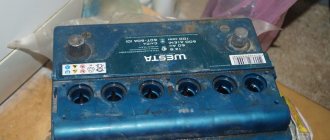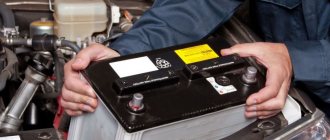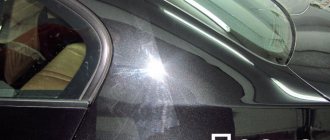Information site about energy storage devices
A car battery is a storehouse of electrical energy, the renewable supply of which occurs due to an electrochemical reaction in several cells. Each bank provides equal amounts of energy. The elements are connected in series, the voltage in the battery is equal to the sum of the resulting potential differences of all banks. If one element fails, the battery becomes unusable. How to find out the cause of the malfunction - is the bank shorted in the battery or is there an open circuit?
Battery banks are shorted - symptoms
Here is a classic lead acid battery consisting of 6 cans. Each of them is composed of pairs of oppositely polar plates. Their contacts are collected into a common collector, connected in series and connected to the cover with two terminals. Modern cans have a different design, but the layout of the cans and cells is the same.
With a series connection, the cell voltages are summed up, and the capacity is determined by the most clogged bank. To charge the battery, voltage is applied to the terminals and current flows through the storage areas. Why do banks short circuit in a lead-acid battery? If for some reason the plates in the jar get closer together, the walls swell, a jumper is created, and the cell is closed. It happens that a contact bridge is created by a piece of crumbled putty or scale.
How can you check if the battery is short-circuited? When measuring the voltage at the terminals, a dip will be detected. For example, a 12 V battery consists of 6 cans with a total voltage of 2.1 * 6 = 12.6 V. The voltage drops to 10.5-11.0 V - look for a closed can.
One of the plates inside the jar is lead, and the other has a layer of active substance applied to it. If the electrolyte level is violated or overcharged, the mass may crumble and short-circuit the plates.
Mechanical damage from the outside can lead to deformation. It is possible that the battery case is swollen, and then internal short circuits of the plates in the banks are possible. This can happen when the electrolyte freezes and from overcharging a maintenance-free battery.
Symptoms of a shorted battery bank are loss of voltage, heating of the battery case. The battery does not charge to 12 volts, is unable to crank the starter, and requires replacement. Sometimes when charging you can hear the smell of rotten eggs - hydrogen sulfide gas is released.
Video
It’s better to see once how specialists eliminate the consequences of shorted cans. How to restore a shorted battery bank, watch the video.
Topic in the “Audi Repair” section, created by serj32, January 5, 2011.
You are using an outdated browser. This and other sites may not display correctly. You need to update your browser or try using a different one.
When the electrolyte begins to boil when charging a battery, many car enthusiasts have questions about the possible consequences of this phenomenon. For each battery, such processes have different intensity: from the release of small bubbles to active seething. We'll tell you why this happens and what measures need to be taken in such cases.
Signs of a shorted battery bank
Since charge is being redistributed inside, the battery case heats up, which is one of the signs of an internal short circuit. If the battery is serviceable, you can determine the shorted bank during charging. At the moment the voltage rises, the plugs on the cans are open, hydrogen is released from them, and the cans boil. If one does not show signs of life, it is closed. You can check and find the cause of undercharging of the battery in a ventilated area or outside.
If a voltage drop occurs in a maintenance-free battery, the device does not charge to operating voltage, as you can determine if the bank is shorted, or for another reason. Experts advise closing the contacts for 1-3 seconds. A copious discharge will begin from the non-working jar.
Even a maintenance-free battery allows you to see the electrolyte level in the jars through the translucent walls. Signs of a closed jar will be a reduced level of electrolyte - it boils away, sometimes a noticeable change in color to black.
Preparation
So, if, as a result of checking with a hydrometer, a low density of the electrolyte in the battery is discovered, it needs to be raised. But before doing this, you need to make sure that some conditions are met:
- The battery is charged;
- the temperature of the electrolyte in the jars is within 20-25 °C;
- in all jars the liquid level is normal;
- the battery is intact. On batteries, cracks often appear near the current terminals due to loosening of the contacts. Therefore, there is no need to knock or use excessive force to remove the terminal on the battery. It's better to spend a little more time and do it carefully.
If the car battery is discharged, it is charged, and then the density is measured. Why is that? The fact is that with a low charge, the concentration of acid in the jars decreases.
If you pour the correction solution into an uncharged battery, the concentration of sulfuric acid can be increased to such an extent that the plates in the jars will fall off.
It is also necessary to take into account the fact that a car generator charges the battery only 85-90%. Therefore, before taking measurements, the battery must be charged.
Corrective battery charging
Sometimes, a situation may arise that after a full charge, the density of the electrolyte in the banks turns out to be different. In general, the difference in density is allowed no more than 0.01 kg/cm3. Otherwise, it needs to be leveled.
To do this, you can perform corrective charging of the battery. The current strength is reduced by 2-3 times (compared to the nominal value) and the battery is charged in 1-2 hours. If this does not help level the electrolyte density, more radical measures will be required.
Correction electrolyte
Corrective is called an electrolyte with a density of 1.40 kg/cm3. Remember, under no circumstances should you just pour it into the battery. Those. first, you need to check the battery and find out the reason for the drop in the liquid level, and then raise it.
There is often a situation where novice car enthusiasts misinterpret the name “corrective”. For example, when the water evaporated from the cans. Those. you need to raise the liquid level, and here is the corrective solution. The logic is simple:
- The battery is filled with electrolyte and its level has dropped;
- correction solution, which means it is intended to adjust the liquid level.
Unfortunately, this point of view is fundamentally wrong. In most cases, distilled water is poured into the battery to level the level.
And the corrective electrolyte is poured in the following cases:
- if liquid has leaked from the cans;
- if you poured too much distillate into the battery and reduced the density.
Therefore, there is no need to pour it if, for example, the battery is simply discharged, and accordingly the concentration is lower than required.
How to identify a closed cell in a battery
Technically, you can determine a closed bank by measuring the voltage on each bank separately with a voltmeter. To measure the voltage on each bank you need to use a load fork. Under load, the voltage of the can below 1.7 V indicates its defect.
The most reliable testing method is carried out on a completely discharged battery. The battery should produce a voltage of 12 V. The indicator is less by a number that is a multiple of 2 and will determine how many cans have become unusable. In the future, you will need to determine why the bank closed. If the battery is expensive and new, less than 3 years old, it can be revived. But for this you need to have plumbing skills, tools and follow safety precautions.
Reasons for the short circuit of cans in the battery
The main problem is failure to follow the operating instructions for the car battery. Closely spaced plates, active putty on the gratings, are precisely designed to work under the flood, with voltage within the permissible limits. The crumbled mass, sulfation, and a sharp blow to the body are a prerequisite for the contact of the plates with opposite charges. If one bank is overloaded, it will discharge faster, become sulfated, and the first one will fail.
What should I do to prevent the battery from shorting out and to keep it working for a long time? Keep the battery clean, avoiding unnecessary self-discharge currents. Do not leave a discharged battery for a long time without recharging. In the cold, a discharged battery will freeze because it contains a weak electrolyte. Often, just because of 1 cell of battery, you have to recycle the entire battery. There are several reasons why it can close:
- Factory defects are a warranty case.
- Strong blow to the body.
- Chronic undercharging and overdischarging is the most common cause of malfunction.
Leveling with a charger
Everything is simple here. The only condition is that you will need a charger for the car with strict regulation of the output voltage. Automatic chargers that reduce the current when fully charged are not suitable.
How to restore density:
- The battery is brought to full charge;
- when it is charged and begins to boil, the current strength decreases to 1-2 Amperes;
- The logic is simple - the battery boils, the water evaporates, the electrolyte concentration increases;
- evaporation time depends on the specific case and can last more than a day;
- when the level drops, the electrolyte is added and the density is measured;
- if necessary, the operation is repeated.
Of the minuses, it is worth noting that it takes a long time.
If the density is too low
How to equalize the density if it is too low? For example, if its value is below 1.18, the described methods will not work. You will have to drain the acid completely.
Let's figure out what to do in this case:
- the electrolyte is pumped out of the cans as far as possible;
- The battery is carefully turned over, and holes are drilled in the bottom in each can.
- It is advisable to do this in some container, for example a basin;
- after this, the battery is placed in a vertical position, and the remaining liquid is poured out of it;
- the battery is washed with distilled water;
- the holes are sealed and new solution is poured.
The plastic used to seal the holes must be resistant to sulfuric acid.
Sometimes there are situations when old batteries have no density at all. This indicates deep sulfation. In this case, more serious recovery measures will be required.
In fact, if the density of the electrolyte in your battery has dropped, this is not such a big problem. And you can lift it without much difficulty. But, only if you determine the drop in concentration in time. If you don’t take care of the battery, it will simply fail.
Surely most motorists have encountered a situation where a car left for some time stops starting. In this case, the starter may not show any signs of life at all. The main reason for this is most likely the battery, which was completely discharged in a few days. Trying to charge it in this case will not lead to a positive result. This problem is the result of a decrease in the density of the electrolyte that is poured into the battery banks...
THE CONTENT OF THE ARTICLE
After all, this liquid is essentially a catalyst for the electrochemical process; without it, the battery is a set of lead and plastic that will not work. As you and I know, it consists of distilled water (approximately 65%) and sulfuric acid (35%), this liquid has a certain density, which can decrease and increase, depending on the charge.
Recovering a shorted battery bank
Once it has been possible to understand that the car battery banks are shorted, it is necessary to evaluate the work to restore the cell and compare it with the purchase of a new device. If more than one can is shorted, there is no point in wasting time and effort on repairs. How do you know if there are still jumpers in other elements? They can appear if the layout of the case is disturbed or the connections are loosened.
Step-by-step instructions on how to restore a shorted battery bank.
- Identify a non-working jar based on the listed characteristics.
- Extract the electrolyte using special means, working in glasses and rubber gloves.
- Cut the plastic around the top of the cell.
- Disconnect the jumpers with adjacent elements and carefully remove the package of plates, rinse them from acid.
- Determine the location of the short circuit - a piece of metal, a bent plate, remove sediment at the bottom.
- Place the structure in place as it was, fill in the electrolyte, and secure the lid with glue.
- Fully charge the battery.
This is how lead batteries of older models and those produced in Europe are restored. Maintenance-free batteries must be protected from deep discharge. It is difficult to repair them yourself.
Reinsurance: we charge the car battery efficiently and correctly
You need to know that if the battery heats up during charging, this is a completely natural phenomenon, especially when the process comes to an end. In order to avoid overheating, it is important to monitor the battery at all stages of its charging - in much the same way as we monitor a pan or any electrical appliance placed on the fire.
Before connecting a lead-acid battery to the network using a charger, always check the electrolyte level in each “can” to avoid rapid overheating and short circuit between the lead plates that are not covered with liquid. Remember that the level of electrolytic fluid in the battery banks should always cover the plates by at least 1 centimeter . Before charging, be sure to measure the density of the liquid with a hydrometer (the norm is 1.27 g/cm 3 ).
Also remember that the battery can be charged in two main ways: with a constant current level, or vice versa, with a constant voltage level set on the charger. If you charge the battery with direct current, its level should be no more than 10% of the actual battery capacity. If the current is higher than expected, this can cause the battery to overheat and boil ahead of time, which will subsequently negatively affect its performance. If you do not follow the process and do not reduce the current level in time, the battery may even explode.
Towards the end of charging, do not leave the battery unattended for a long time. If it starts to heat up too much, it is better to reduce the current. Of course, charging time may increase, but this is what will allow you to minimize possible risks.
In addition, if your battery is already old, it is important to keep in mind that older car batteries heat up faster, and you will have to add distilled water more often to avoid a short circuit. Handle the old battery with the utmost care and caution.
Reasons for the boiling process
To understand whether a battery should boil at the end of charging, it is necessary to find out the reasons for the occurrence of this phenomenon, and for this let’s remember school courses in chemistry and physics. Modern cars use lead-acid batteries as a source of electricity. Most batteries have 8 or 6 sections (cans), each of which contains lead grids immersed in an electrolyte - an aqueous solution of sulfuric acid.
When a charger is connected, many chemical reactions occur inside the battery, but we are interested in the reaction that causes “boiling”. When current is applied to the lead grid, a chemical reaction occurs in the solution - electrolysis of water. The release of hydrogen and oxygen begins with a simultaneous increase in the density of the electrolyte. Motorists call this phenomenon boiling, although in our case this is not entirely true. The temperature of the hydrochloric acid solution does not reach the value at which boiling begins, and the observed processes are the release of detonating gas (a mixture of oxygen and hydrogen).
Possible factory defect of the new battery
For novice drivers, it will also be useful to know that the process of boiling the battery itself can tell you why it gets very hot and for what reasons its total voltage does not meet the required standard.
For example, when one of the cans shorts due to a factory defect, boiling occurs as a normal and natural process in all serviceable battery compartments . There is no boiling process in a closed jar. When measuring the density of the electrolyte, its value in the “dead” compartment does not exceed 1.10 g/cm 3 . A battery with such a defect will produce a voltage of about 10.5 Volts, and not the required 12-13 at rest. It is better not to try to restore it, but to return it back to the store, or exchange it for a working one.
Possible problems if the battery gets very hot when charging
If you removed the battery from the car and set it to charge, and later discovered that it heats up more than necessary, the reasons may be quite understandable and sometimes removable:
- The charger used is faulty, or the currents are too high. Just try to reduce them.
- Something happened inside the battery itself. This may be damage to the plates, their shedding or a short circuit. The ability to correct the problem depends on the level of damage to the plates.
Why does my phone battery heat up when charging?
Most often, phone owners’ concerns about this have no serious basis:
- If the phone is charging and there are no obvious signs of overheating, then charging can be safely continued: all mobile phones “heat up” when connected to the network .
- If you make calls, play games or text while your phone is charging , its temperature will naturally be an order of magnitude higher than normal. In this case, you can wait for the device to finish charging so as not to worry again.
- If the body of your gadget is made of metal , it will heat up more, but there is no danger in this.
- When connecting to a smartphone Wi-Fi or any type of mobile Internet, downloading data will affect the temperature level during charging.
- The phone may heat up due to errors in the firmware system (program code). In this case, try to find an updated firmware version on the Internet.
- check the heating level of your smartphone during charging using a utility like CPU-Z .
Thus, any battery heats up when charging. When it comes to a car battery, it is important to carry out timely monitoring of the process in order to avoid possible irreversible damage. If the phone heats up, most often the users’ worries are in vain. But if in doubt, the heating level of the battery during charging can always be checked using special programs.
The battery is an extremely important component of any modern car. This is a necessary element that ensures engine starting and performs a number of additional functions.
At the same time, the battery needs to be recharged so that the battery does not run out and lose its functionality. Batteries in cars are charged from the generator as the car moves, and from special chargers.
When the battery reaches its full charge, the compartments inside the device, called banks, gradually begin to seethe. A boiling effect occurs due to exposure to electric current. During the boiling process, hydrogen and oxygen are released. In situations where charging went well, all compartments or jars boil. But it happens that one or more cans do not boil and no bubbles are released. Because of this, car owners are starting to worry a lot. Not everyone knows whether this is a normal phenomenon or not, what to do in such a situation, and why some jars suddenly stop boiling. Although everyone else is seething normally.
Why doesn’t one “compartment” boil?
Again, there are not many main reasons, sometimes this indicates the battery has failed - it’s just time to change it, but there are also cases when the battery can be restored,
- It does not boil because it has shorted out , a foreign object has entered, or the plates have fallen off, which is why the charge is not flowing.
- Charge imbalance. This also happens, but rarely. For example, five cans are charged and boiling, but for some reason the sixth has not yet been recharged.
- The battery just ran out. The last jar completely crumbled, the electrolyte in it was cloudy.
What should you do, throw away the battery? Take your time, because in 50% of cases it can be restored.
Why do they boil and is this normal?
The first thing to note is that banks are called compartments in batteries. There are lead plates inside them. In total, car batteries use 6 compartments, that is, cans. Each of them, when fully charged, produces 2.1 Volts. When connected in series, we get the same 12.6 or 12.7 Volt battery.
Boiling car battery
The boiling effect is not difficult to see with your own eyes if you have a serviced battery in front of you. To look at the seething, just unscrew the special plugs. However, not everyone understands why the compartments boil, and whether such behavior is the norm for batteries.
Yes, boiling is considered a completely normal process, which often only indicates that the battery is already fully charged. This causes gas to be released. When exposed to electric current, the water inside the battery gradually breaks down into oxygen and hydrogen. Because gases are lighter than water, they tend to rise and come out as bubbles.
The gas released in this process is highly explosive. Under no circumstances should sparks or contact with open flame sources be allowed. Otherwise, you risk exploding the battery and damaging everything around the battery. That is, trying to look at the bubbling liquid in the battery by illuminating it with a lighter or matches is a very bad idea.
When bubbles begin to appear, this clearly informs the car owner that the device is charged, and you can disconnect it from the charger. You should not leave the battery connected to the charger for a long time, since then the overcharging effect will begin. There is nothing good about it. The boiling activity will increase, the liquid level will gradually begin to fall as water leaves the electrolyte.
In the normal state, lead plates are deliberately completely immersed in the electrolyte. This is by design to avoid overheating and ensure efficient operation. If the electrolyte level drops, then the plates will be exposed. In the future, you will experience overheating and destruction of the battery with all the ensuing consequences.
There is a category of car owners who are trying to specifically provoke the release of bubbles. Thus, they strive to increase the density of the electrolyte used in batteries. The calculation is that the excess water will supposedly boil away and evaporate, but the acid will remain in its place. Due to this, the density will increase.
Restoring a car battery bank
There is nothing terrible in waiting for the bubble to bubble while charging the battery on a special device, and then immediately turn off the power to the charger. Just don’t overexpose and let the battery boil for too long. At the same time, it is better to maintain a short boil at low currents, so as not to provoke excessively intense boiling and gas evolution. If you apply a high current, the bubbling will be too active, thereby rendering the battery completely unusable for further use.
Why one compartment may not boil
But sometimes it happens that when charging a car battery, one of the cans does not boil. Some car owners immediately begin to worry, panic and send the battery to a well-deserved rest.
Car battery boiling process
There are not many reasons for this phenomenon. Sometimes this is really a signal that the battery life is coming to an end, it is no longer capable of working fully and needs to be replaced. But it also happens differently. The absence of signs of seething in one of the compartments does not put an end to the battery, and there is a possibility of its restoration.
It is necessary to clarify in more detail why, when charging your battery, not all available banks boil, that is, not all 6 compartments.
- There is no boiling process, because a short circuit has occurred, there are some foreign objects inside the battery or the plates have begun to crumble. Due to such phenomena, the bank may not receive a full charge. Hence the lack of seething in the compartment.
- An imbalance has occurred. The situation occurs, but is extremely rare. Sometimes it happens that 5 out of 6 cans have already been charged and are starting to boil, but the last one has not yet received the required charge. With such a malfunction, the last compartment boils, but with a slight delay, when the rest are already boiling.
- The battery has exhausted its resource. Rechargeable car batteries should be treated as consumables. They have their own limited lifespan. If the battery is not the most expensive, or purchased on the secondary market, do not be surprised that after 1-3 years of service it will stop functioning normally. The jars may crumble, and the electrolyte inside may become cloudy. There is no point in restoring the battery. You need to buy a new one.
But you shouldn’t rush to send the battery to a landfill when one of the cans for some reason stopped boiling during charging. Yes, if boiling occurs while the engine is running, when the charge is coming from the battery, you need to figure out the reasons and definitely get rid of the battery.
If we are talking about the charging process through a special device, then in approximately half of the cases when there is no seething in one of the compartments, the battery is still recoverable.
What to do?
I will say this, if you still throw out the battery, you can experiment with it - a friend of mine managed to revive the battery, in principle, nothing complicated, you just need to think about it, so let’s go point by point:
- To restore a jar is to remove a foreign object from it. Sometimes it is enough to “rinse” it, sometimes drastic methods are needed, as described in this article. If there is really a small piece that “shorts” the plates, then performance will be restored by 90 - 95%. Then you can charge this one compartment, or read the second point.
- Charging is also easy . You need to “set” all the banks to “zero” (that is, they are, as it were, “leveled”), usually this is done by a load, for example, you can connect a lamp from a headlight to the terminals. In about a day the battery will be completely discharged. Then we put the battery on charge, now all “compartments” should absorb the energy, that is, six will already be boiling.
- If you dismantled the cloudy compartment , pulled out a package of plates, and they crumbled in your hands, then there is nothing you can do here, this is complete destruction. Most likely, the picture is the same in other banks. So it’s just a matter of buying a “new” battery!
To be honest, it is not always possible to restore it, and washing does not help, only experienced craftsmen can do this for you. The first point is the most difficult, you will have to cut the battery case, but there is acid in there (be sure to protect your hands) - if the restoration was successful, then you need to hermetically seal the case.
I would like to summarize the subnetwork and assign you a brief action plan.
If one jar does not boil, then:
- We look at the electrolyte - in a transparent battery (made of white plastic) it will be visible through the walls, if the battery is dark in color, then you need to “suck it in” with something (ideally a hydrometer) and pour it, say, into a glass.
- If the liquid is clear , then most likely the jar is either shorted or not fully charged. If the liquid is cloudy, there is a high probability that the plates will completely fall off.
- If the liquid is clear, we first try to equalize the charge. We discharge to zero, then recharge. If again everyone is boiling, but one is not. So, we'll take it apart.
- We cut the upper case - take out the plates and look, if there is a short circuit, eliminate it, return the plates back, fill them with electrolyte, and solder the case.
That's all, now let's watch the video version of the article.
This is where I end, I hope the article was useful to you, read our AUTOBLOG
(
25 votes, average: 4.60 out of 5)
What to do right
Immediately prepare for the fact that as a result of the manipulations performed aimed at restoring the device, you will still have to buy a new battery for your car.
Installing a new battery in a car
It cannot be said that when one battery does not boil during charging, the battery is completely unsuitable for further use. You can still drive even on such a device. But you definitely won’t get by with boiling in 1 compartment, while the other sections are not bubbling.
Raising the electrolyte density in the battery
So, let's figure out how to increase battery density. I’ll say right away that although this is not a tricky task, it is quite painstaking and, moreover, takes a lot of time. Therefore, it is better to be patient in advance.
The normal electrolyte density should be in the range of 1.25-1.27 g/cm3. Moreover, this value should be the same for all cans. In order to increase the electrolyte concentration in the battery banks, a correction solution is used. If you want to prepare the mixture yourself at home, remember the sequence:
- The distillate is poured into the container, and sulfuric acid is added to it. If you do the opposite, the solution will begin to boil violently.
In addition, you will need:
- an aerometer with a bulb for pumping liquid out of cans;
- glass container for draining old electrolyte;
- beaker ;
- safety glasses, gloves.
It is also important to remember that the liquid may have different densities in the jars. Therefore, it makes sense to make a simple plate where to enter the measurement results for each jar - otherwise you can get confused.
I’ll make one important clarification right away. Some comrades, advising on how to increase the density in the battery, suggest completely pouring out the electrolyte and filling in a new one. And to do this, they recommend simply turning the battery over, pouring out the liquid and rinsing everything with distilled water. And as a result of such manipulations, one or more cans stop working.
Why is this happening? The fact is that lead sediment collects at the bottom. And if the battery is turned over, pieces of lead can fall between the plates and short-circuit them. Those. the bank stops working.
So, when the electrolyte density has dropped, there are several effective methods to raise it painlessly. Let's look at them.











